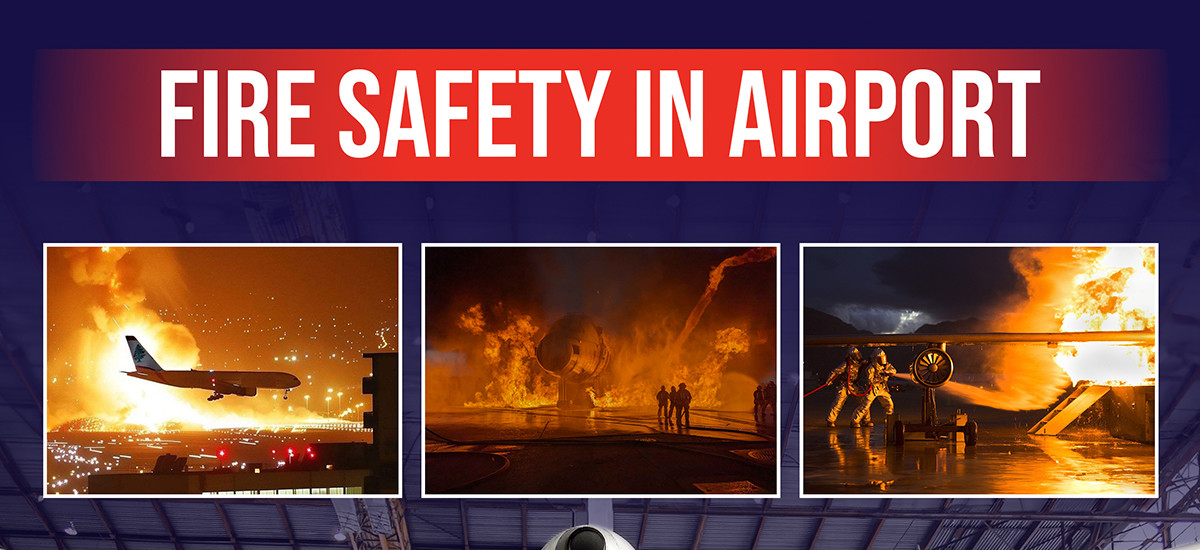26/6/2025
Airports are the heart of modern transportation and include many moving parts, from aircraft hangars to refueling stations, passenger terminals to maintenance facilities. This diversity brings with it significant fire risks, so it is of great importance to develop an effective fire safety strategy in every premises. This article explores the basic elements of fire safety at airports and highlights the factors that can minimize potential risks and enhance overall fire protection.
Fire Risks Specific to Airports
Airports present unique fire hazards due to the combination of high-energy aircraft operations, flammable fuels, maintenance procedures, and passenger activities. The United States-based NFPA (National Fire Protection Association), a pioneer in airlines and passenger transportation, has identified fire risks and safety measures in the aviation industry. The main factors are fuel ignition, aircraft electrical systems, and maintenance operations. Therefore, fire safety measures must cover both airborne and ground-based risks.
Passenger Terminals: Balancing Security and Functionality
Passenger terminals are high-traffic areas with many potential ignition sources, such as restaurants, baggage conveyors, and complex electrical systems. In these busy areas, the implementation of state-of-the-art fire detection and suppression systems is essential for both life safety and infrastructure protection.
Modern fire safety solutions include preventing the spread of fire with smoke control systems, ensuring safe evacuation with emergency evacuation plans and increasing the resilience of structures with fire-resistant materials. These solutions should be tailored to the needs of the airport, determined through risk assessments and simulations.
Aircraft Hangars: The Foundation Point of Fire Safety
Since aircraft hangars house the most valuable investment in the aviation sector, ensuring fire safety is one of the most important priorities. In these types of facilities, which contain large volumes and few compartments, the correct integration of both active and passive fire protection systems is critical. Both active solutions such as foam extinguishing systems, rapid fire detection technologies and passive measures such as fire-resistant walls and insulated partitions must work together.
Refueling Operations: Controlling the Most Volatile Risk
Fuel handling and storage is one of the highest fire risks at airports. From aircraft refueling stations to underground lines and storage tanks, every stage of the fuel management process must be designed in accordance with strict safety protocols. In this context, NFPA standards specify comprehensive safety measures for aircraft refueling, emphasizing the importance of spill prevention, static electricity management, and emergency shutdown systems.
Advanced security solutions against fire risk and fire-resistant infrastructure, automatic closing mechanisms and emergency response plans must be implemented correctly at refueling stations.
Ensuring Compliance with Aircraft Maintenance Processes and Fire Safety
Aircraft maintenance activities include many procedures that increase fire hazards, such as welding operations, fuel tank inspections, and component testing. NFPA standards provide guidelines for safe aircraft maintenance practices, requiring proper ventilation, fire-resistant equipment, and separation of flammable materials. Maintenance procedures should be evaluated considering fire safety conditions, and emergency response strategies should be developed by taking precautions against fire in work areas.
Emergency Preparedness and Response: The Importance of Rapid Reaction
The most important element in any fire that may occur at airports is a well-prepared emergency response plan. NFPA standards and ICAO regulations specify aircraft rescue and firefighting protocols in detail. Firefighters working at airports must be equipped with special vehicles, high-performance extinguishing systems and rapid response capacity. It is of great importance to ensure that personnel act effectively in the event of a fire with training programs and emergency planning.
Result: Continuous and Proactive Security Approach
Fire safety at airports is a dynamic area that requires constant innovation, evaluation and updating. Regular updates from international institutions such as ICAO and NFPA support the implementation of the most up-to-date security measures at airports.
In recent years, there have been developments such as increasing the sensitivity of smoke evacuation systems and switching to environmentally friendly fire extinguishing agents.
By closely following the most up-to-date fire safety standards and innovative systems, a high level of fire resistance can be created at airports through professional fire engineering and consultancy services, thus ensuring the safety of passengers, personnel and aviation assets.
To effectively implement fire safety measures in airports, a thorough understanding of both national and international standards and aviation regulations is essential. Efectis’ fire consultancy team, with expertise in national and international standards, is equipped to address your specific fire safety needs with tailored technical solutions.

